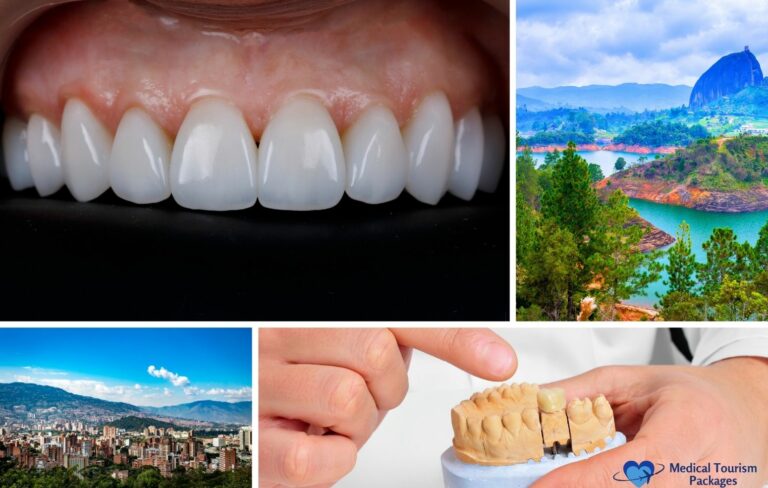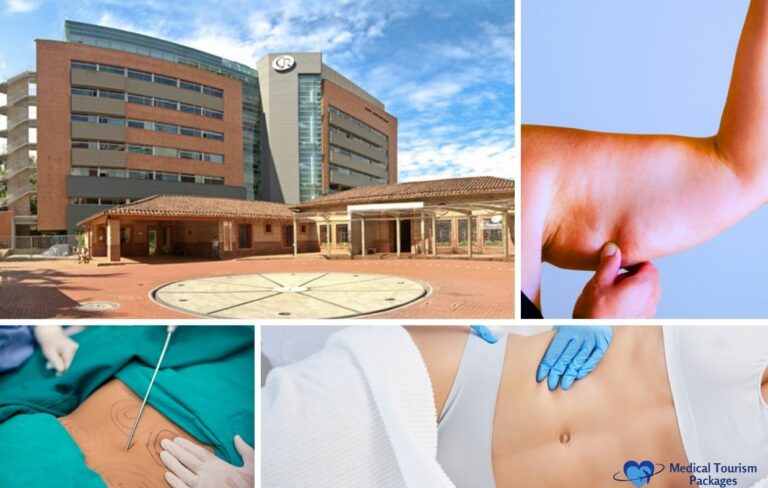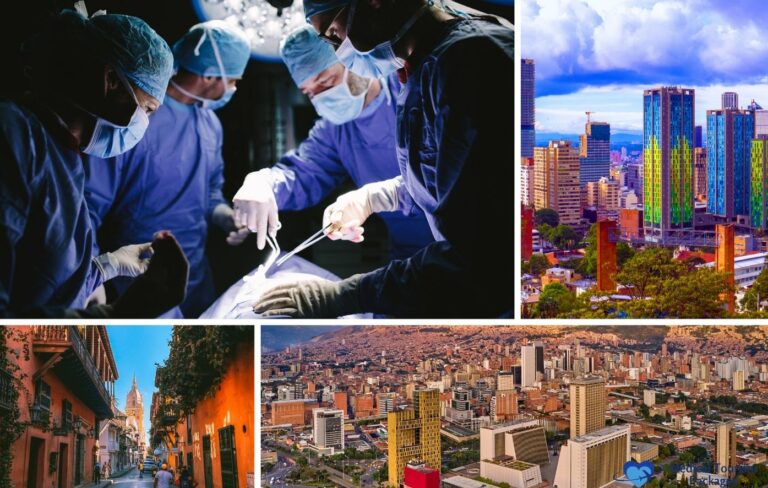Book Appointment Now
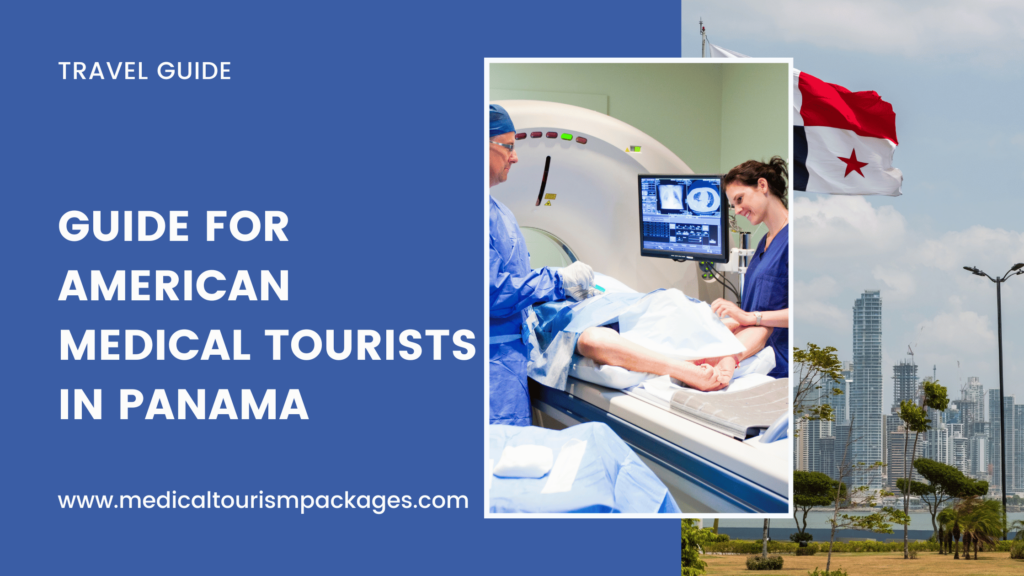
A comprehensive guide for American Medical Tourists in Panama
Are you considering traveling abroad for medical treatment? Look no further than Panama, a rising star in the world of medical tourism. This comprehensive guide is tailored for American medical tourists exploring Panama’s healthcare offerings.
From cutting-edge procedures at a fraction of the U.S. cost to the warmth of Panamanian hospitality, discover why this Central American gem is attracting health-conscious travelers. With its strategic location, use of the U.S.
dollar, and English-speaking medical professionals trained in the U.S., Panama stands out as an accessible and appealing destination. Whether you’re seeking advanced dental work, cosmetic surgery, or specialized treatments, Panama combines quality healthcare with the allure of tropical escapades. Dive into our guide to learn how to navigate Panama’s healthcare system, understand cost benefits, and prepare for a seamless medical journey that blends healing with adventure.
What is Medical Tourism in Panama?
Medical tourism in Panama is a burgeoning sector that attracts individuals from all corners of the world, seeking to access medical services, treatments, and procedures. These services might be either unavailable, more expensive, or subjected to longer waiting periods in their home countries. This trend capitalizes on Panama’s strategic geographic location, its adoption of the U.S. dollar, and a high standard of healthcare facilities, alongside the availability of U.S.-trained, English-speaking medical professionals. This makes Panama an appealing destination for medical tourists. The country offers a broad spectrum of medical services including, but not limited to, cosmetic surgery, dental procedures, orthopedic surgery, and more, all at competitive prices.
Unique or Highly Sought-After Medical Treatments in Panama:
- Stem Cell Therapy: Not widely available in the U.S. due to regulatory restrictions, Panama offers advanced stem cell treatments for a variety of conditions, including anti-aging and chronic diseases.
- Holistic Wellness Programs: Integrative approaches combining modern medicine with traditional healing practices, tailored to individual health needs.
- Panama welcomes approximately 50,000 medical tourists each year, a number that has been steadily increasing due to the country’s growing reputation as a healthcare destination.
Furthermore, Panama enhances the medical tourism experience by doubling as an attractive tourist destination, boasting rich biodiversity, vibrant culture, and modern amenities. This unique combination allows individuals to blend healthcare with leisure and recovery in a highly desirable setting. This synergy between high-quality, cost-effective healthcare services and the country’s tourist appeal solidly positions Panama as a prominent player in the global medical tourism industry.
Why Americans Choose Panama for Healthcare?
Americans are increasingly turning to Panama for healthcare due to several compelling reasons. Cost-effective treatments stand out as a primary motivator, with procedures often available at a fraction of the cost compared to those in the United States. This affordability does not come at the expense of quality, as Panama boasts high standards of care, with many facilities holding international accreditation and staffed by specialists who frequently have training and qualifications from the U.S.
The country’s geographic proximity to the US further enhances its appeal, offering relatively short travel times compared to other global medical tourism destinations. This convenience is coupled with English proficiency among healthcare professionals, easing communication and making the medical process smoother for English-speaking patients. These factors—cost savings, quality of care, proximity, and language compatibility—collectively make Panama an attractive healthcare destination for Americans seeking affordable healthcare solutions outside their country of residence.
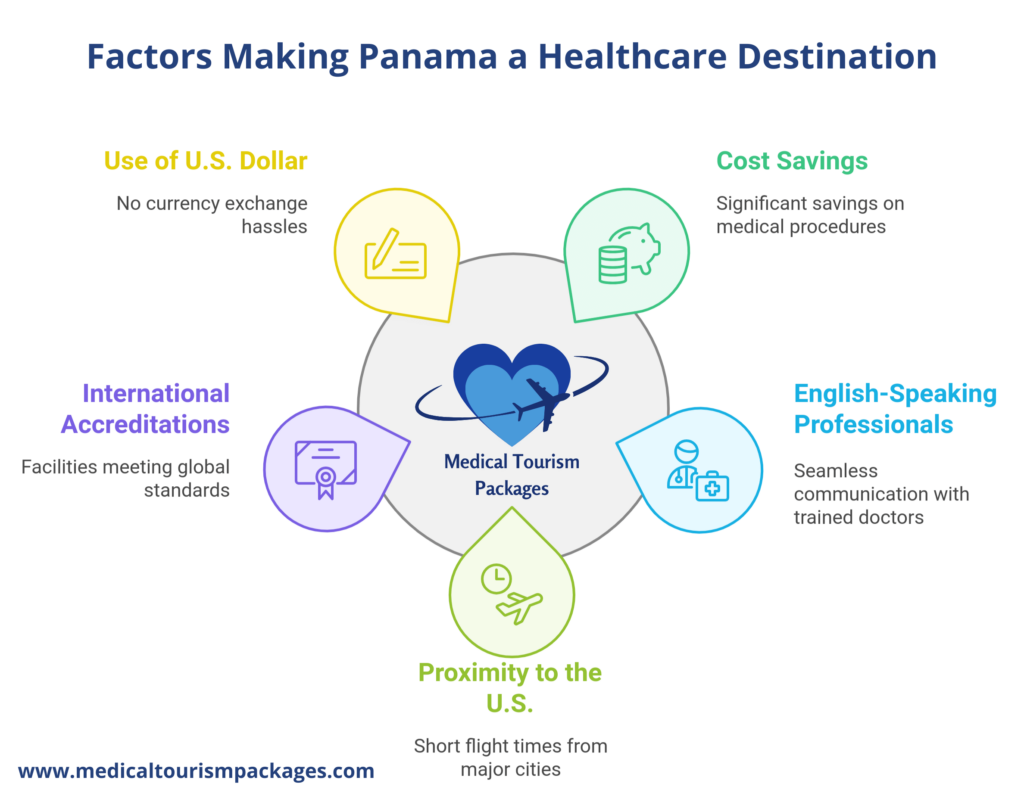
To reinforce the section’s relevance and helpfulness, consider the following specifics:
- Comparative Cost Analyses: On average, medical procedures in Panama can cost 50-70% less than in the United States. For instance, a knee replacement surgery that might cost around $35,000 in the U.S. could be as low as $15,000 in Panama.
- International Accreditations: Many Panamanian healthcare facilities have been accredited by international bodies such as the Joint Commission International (JCI), ensuring they meet high global standards. For example, Hospital Punta Pacifica in Panama City is JCI-accredited, providing reassurance of quality care to international patients.
- Direct Quotes from Americans: “The cost of my dental work in Panama was less than half of what I would have paid back home, and the quality of care was exceptional,” shares John, a retiree from Florida. “Not only did I save money, but I also enjoyed exploring Panama during my recovery.”
Cost-effective Treatments
Panama offers cost-effective treatments, significantly lowering the financial barrier for quality healthcare. This affordability is a major draw for Americans looking for the same high-quality services without the hefty price tag associated with healthcare in the United States.
High Standards of Care
The country is recognized for its high standards of care, with many healthcare facilities boasting international accreditations. This ensures that patients receive care that is on par with, if not superior to, what they would expect at home, making it a trustworthy destination for medical services.
Geographic Proximity to the US
Geographic proximity to the US is another compelling reason for American medical tourists. The relatively short distance reduces travel time and associated costs, making Panama an accessible and convenient option for those seeking medical treatment abroad.
English Proficiency Among Healthcare Professionals
A notable advantage for American patients is the English proficiency among healthcare professionals in Panama. This eliminates language barriers, facilitating clear and effective communication regarding treatment plans, procedures, and patient care, thereby enhancing the overall medical tourism experience.
Popular Procedures for American Tourists
American tourists are increasingly drawn to Panama for a variety of medical procedures, attracted by the combination of cost savings, high-quality care, and convenience. Cosmetic enhancements are at the forefront, offering a wide range of aesthetic surgeries at competitive prices without compromising on results. Advanced dental services also see high demand, from routine check-ups to complex surgeries, all performed using state-of-the-art technology.
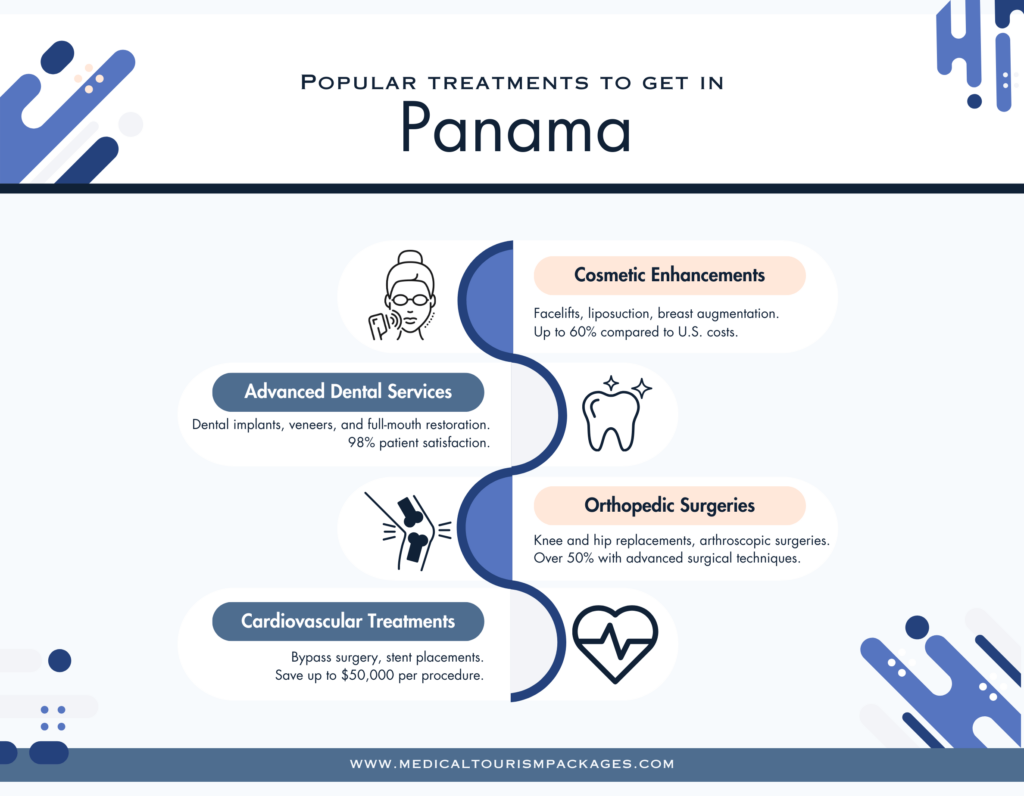
Orthopedic surgeries in Panama provide cutting-edge treatments for musculoskeletal issues, significantly reducing recovery time and improving outcomes. Lastly, cardiovascular treatments in the country utilize the latest medical advancements to manage heart conditions effectively. These procedures exemplify Panama’s appeal to American medical tourists, combining affordability with excellence in healthcare.
| Procedure Type | Average Cost in Panama | Average Cost in U.S. | Average Savings | Success Rate | Patient Satisfaction |
|---|---|---|---|---|---|
| Cosmetic Procedures | $4,000 | $10,000 | 60% | 95% | 4.5/5 |
| Advanced Dental Services | $1,000 | $3,500 | 71% | 98% | 4.7/5 |
| Orthopedic Surgeries | $8,000 | $20,000 | 60% | 90% | 4.6/5 |
| Cardiovascular Treatments | $15,000 | $50,000 | 70% | 93% | 4.8/5 |
Cosmetic Enhancements
In Panama, patients can access a broad range of cosmetic enhancements at significantly lower costs without sacrificing quality. Popular procedures include facelifts, liposuction, and breast augmentation, performed by skilled surgeons. This makes Panama an attractive option for those looking to enhance their appearance affordably.
Advanced Dental Services
Advanced dental services in Panama stand out for their use of cutting-edge technology and affordability. From routine dental care to complex procedures like dental implants and veneers, patients receive top-tier dental treatments that combine quality with cost-effectiveness.
Orthopedic Surgeries
Panama is a destination for orthopedic surgeries offering the latest in treatment options for musculoskeletal issues. With procedures like joint replacement and arthroscopic surgery, patients benefit from minimized recovery times and maximized outcomes, facilitated by advanced surgical techniques.
Cardiovascular Treatments
The country also excels in cardiovascular treatments, providing a wide range of services from minimally invasive procedures to comprehensive heart surgery. Utilizing the latest advancements in medical technology, these treatments are conducted by highly qualified professionals, aiming for the best possible management of heart conditions.
Selecting a Healthcare Facility
When choosing a healthcare facility in Panama, patients should prioritize international accreditations, as these signify adherence to high standards of care and patient safety. Investigating the qualifications of specialists is crucial to ensure that care is received from experienced and skilled professionals. Additionally, considering patient satisfaction ratings can offer valuable insights into the quality of care and patient experiences at the facility.
These factors combined help ensure that individuals select a healthcare facility that best meets their medical needs and expectations, contributing to a successful and positive medical tourism experience.
International Accreditations
International accreditations are a key indicator of a healthcare facility’s commitment to maintaining global standards in patient care and safety. These certifications reassure patients that the facility adheres to stringent quality controls.
Specialist Qualifications
Evaluating the qualifications of specialists is crucial for patients seeking high-quality medical care. Specialists with advanced training and extensive experience are better equipped to provide tailored and effective treatments.
Patient Satisfaction Ratings
Patient satisfaction ratings provide valuable feedback on the quality of care and patient experience at a healthcare facility. High satisfaction ratings often indicate a facility’s dedication to patient-centered care, effective communication, and overall patient well-being. To further assist in selecting a healthcare facility, the following detailed markdown table includes specific healthcare facilities in Panama that are popular among American tourists, along with their specialties:
| Facility Name | Location | Specialties |
|---|---|---|
| Punta Pacifica Hospital | Panama City | Cardiology, Orthopedics, Cosmetic Surgery |
| Hospital Nacional | Panama City | General Surgery, Gastroenterology |
| Centro Médico Paitilla | Panama City | Neurology, Oncology, Cosmetic Enhancements |
| Clinica Hospital San Fernando | Panama City | Pediatrics, Obstetrics & Gynecology, Cardiology |
| American Hospital | Panama City | Dental Services, Dermatology, Orthopedic Surgery |
Legal and Ethical Considerations
When engaging in medical tourism in Panama, it’s critical to navigate the country’s healthcare regulations to ensure compliance with local laws and international standards. Understanding patient rights is essential for safeguarding personal health information and receiving informed consent for treatments. Moreover, considering ethical medical practices is paramount, ensuring that the care received is not only effective but also morally sound.
These considerations are fundamental in ensuring a safe, respectful, and successful medical tourism experience, aligning with both legal requirements and ethical standards.
Navigating Panama’s Healthcare Regulations
Navigating Panama’s healthcare regulations is a key step for medical tourists. It ensures that treatments and procedures comply with the country’s legal standards, including proper facility licensing and accreditation. A detailed exploration of Panama’s healthcare laws can provide insights into:
- Privacy Laws: How patient data is protected and the confidentiality standards medical facilities must adhere to.
- Medical Malpractice Laws: Understanding the legal recourse available in case of medical negligence or malpractice.
- Pharmaceutical Regulations: Guidelines on prescription medications, including how they can be obtained and transported.
Understanding Patient Rights
Understanding patient rights in Panama is crucial for patients to actively participate in their healthcare decisions. This includes rights to privacy, informed consent, and access to medical records, ensuring a transparent and respectful healthcare experience. Key patient rights include:
- Right to Informed Consent: Ensuring patients are fully informed about their treatments and consent to them.
- Access to Medical Records: Patients have the right to view and obtain copies of their medical records.
Ethical Medical Practices
Commitment to ethical medical practices is fundamental in Panama’s healthcare system. This ensures that all medical interventions prioritize patient welfare, uphold non-discrimination principles, and respect patient autonomy, maintaining the integrity and trust in healthcare services. Important ethical considerations include:
- Non-Discrimination: Ensuring equal treatment and access to healthcare regardless of race, gender, or socioeconomic status.
- Patient Autonomy: Respecting patients’ rights to make informed decisions about their own healthcare.
- Beneficence: Healthcare providers must act in the best interest of the patient, promoting good and preventing harm.
Incorporating these specifics into the Legal and Ethical Considerations section provides a comprehensive overview of the legal landscape and ethical framework governing medical tourism in Panama, ensuring that patients are well-informed and protected throughout their medical journey.
Preparing for Your Medical Trip
Preparing for your medical trip to Panama involves several key steps to ensure a smooth and successful experience. Passport and visa requirements must be addressed to secure legal entry into the country. Planning for travel and lodging arrangements is crucial for a comfortable stay during the medical treatment period.
Gathering medical records and ensuring they are organized and accessible is essential for seamless care coordination with healthcare providers in Panama. Lastly, pre-travel medical consultations, possibly with both your local doctor and your chosen facility in Panama, are vital for discussing the specifics of your treatment and any preparatory steps needed. These preparations are foundational in optimizing your healthcare journey and maximizing the benefits of medical tourism in Panama.
Passport and Visa Requirements
- Passport Validity: Ensure your passport is valid for at least six months beyond your planned stay in Panama.
- Visa Information: Check if your country of residence requires a visa for entry into Panama. U.S. citizens can enter Panama without a visa for stays of up to 180 days.
Travel and Lodging Arrangements
- Accommodation: Look for accommodations that offer comfort and are conveniently located near your healthcare facility. Consider amenities that may be beneficial during recovery.
- Transportation: Plan how you will travel to and from medical appointments. Some facilities may offer shuttle services, or you might prefer to arrange for private transportation.
Gathering Medical Records
- Documentation: Compile all relevant medical records, including recent test results, imaging studies, and a list of medications.
- Translation: If your records are not in English, consider having them translated to ensure clear communication with your healthcare providers in Panama.
Pre-travel Medical Consultations
- Consult with Your Local Doctor: Discuss your plans for medical treatment abroad and any preparatory health measures you should take.
- Consultation with Panama Facility: Schedule a virtual consultation with the healthcare facility in Panama to discuss your treatment plan, ask questions, and understand what preparations are necessary.
Checklist for Preparing Your Medical Journey to Panama:
- Legal Documents:
- Valid passport
- Visa (if required)
- Travel and Stay:
- Book flights
- Reserve accommodations
- Arrange transportation
- Healthcare Coordination:
- Gather and translate medical records
- Schedule pre-travel medical consultations
- Health Preparations:
- Get recommended vaccinations
- Prepare a list of medications and medical supplies
- Purchase travel health insurance
Experiencing Healthcare in Panama
Experiencing healthcare in Panama means entering a system known for its high-quality services and patient-centered approach. From the initial medical evaluations to undergoing medical procedures and accessing recovery and aftercare services, patients can expect a seamless healthcare journey. Panama’s healthcare professionals are dedicated to providing comprehensive care, ensuring that each patient’s treatment plan is tailored to their specific needs.
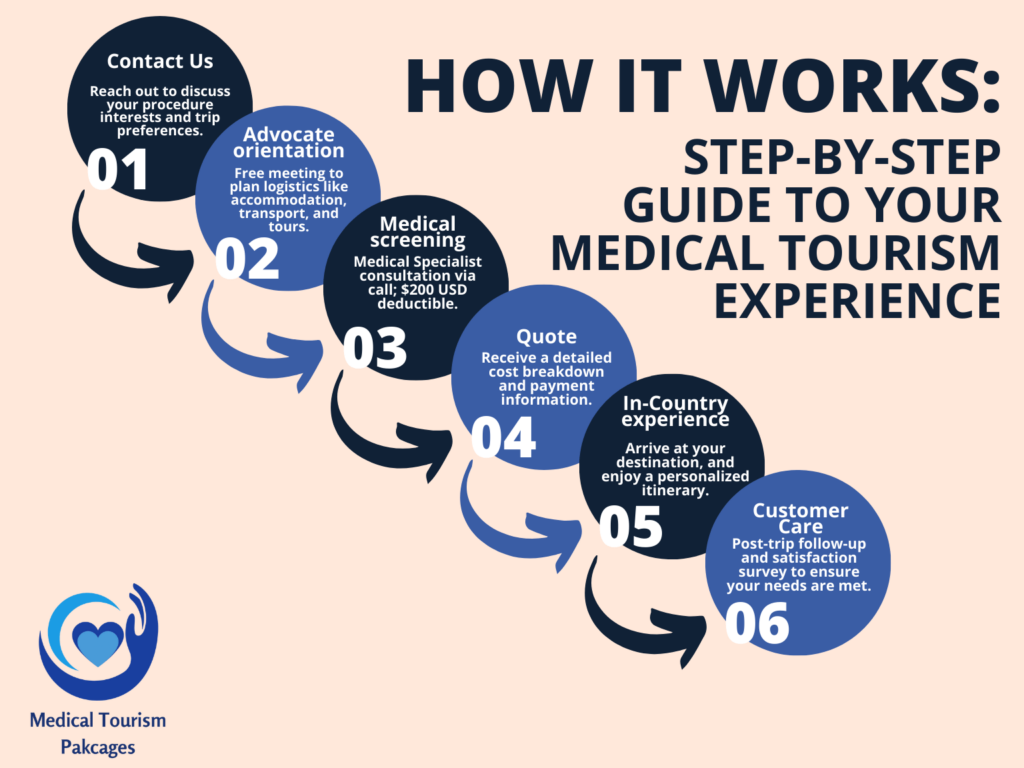
Moreover, the country’s modern medical facilities are equipped with the latest technology, further enhancing the quality of care provided. This commitment to excellence in healthcare, combined with Panama’s welcoming culture and beautiful surroundings, makes the medical journey not just a quest for healing but also an opportunity for a positive and enriching experience. To reinforce the section’s relevance and helpfulness, incorporating personal stories or case studies from patients detailing their experiences with Panama’s healthcare system, from initial consultations through to recovery, would provide valuable insights to prospective medical tourists.
Initial Medical Evaluations
Initial medical evaluations in Panama are comprehensive, aimed at gaining a full understanding of the patient’s health condition. These critical assessments form the foundation for creating a customized treatment plan, tailored to meet each patient’s unique health requirements and objectives.
Undergoing Medical Procedures
When undergoing medical procedures in Panama, patients have access to state-of-the-art medical technology and are cared for by highly skilled professionals. These procedures are conducted with an emphasis on efficiency and effectiveness, striving to optimize recovery times and ensure the best possible health outcomes.
Recovery and Aftercare Services
Panama offers exceptional recovery and aftercare services, providing patients with the necessary support for a smooth recuperation. These services encompass everything from post-operative care to rehabilitation and wellness programs, all designed to facilitate a comprehensive and holistic recovery journey.
Incorporating such personal experiences into the guide would not only provide a real-world perspective on undergoing medical procedures in Panama but also reassure potential medical tourists of the high-quality care and positive outcomes they can expect.
Overcoming Language Barriers
Overcoming language barriers is a crucial aspect of ensuring a positive healthcare experience in Panama for non-Spanish speaking patients. The availability of professional translation services plays a significant role in facilitating clear and accurate communication between healthcare providers and patients. Additionally, the use of technology aids for translation, such as apps and online tools, further enhances understanding and interaction.
Many healthcare facilities in Panama also have English-speaking healthcare providers, making it easier for English-speaking patients to communicate their needs and understand their treatment options. These measures collectively ensure that language differences do not impede access to high-quality care and that patients can make informed decisions about their health.
Professional Translation Services
Professional translation services in Panama ensure that language barriers do not hinder patient care. These services allow for accurate and effective communication between patients and healthcare providers, making medical consultations, consent forms, and procedure explanations fully accessible to non-Spanish speakers.
Technology Aids for Translation
Technology aids for translation, such as mobile apps and online platforms, offer instant translation capabilities. This technology supports seamless interaction between patients and medical staff, enhancing the overall healthcare experience by ensuring clarity and understanding at every step.
English-speaking Healthcare Providers
The availability of English-speaking healthcare providers across Panama’s medical facilities is a key asset for English-speaking patients. This ensures clear, direct communication, enabling patients to convey their health concerns accurately, understand their treatment plans, and make informed decisions about their healthcare.
Facilities with English-speaking Staff:
- Pacífica Salud: Affiliated with Johns Hopkins Medicine International.
- Paitilla Medical Center: Known for its multilingual staff and international patient services.
Understanding Costs and Payments
Understanding the costs and payment options for healthcare services in Panama is essential for medical tourists. The comparative cost of procedures is often significantly lower than in the United States, making Panama an attractive destination for those seeking affordable care. However, patients should be well-informed about the details of insurance coverage and whether their policies are accepted by healthcare providers in Panama.
For expenses not covered by insurance, out-of-pocket costs need to be carefully considered, and patients should inquire about financing options that may be available to them. This financial planning is crucial to ensure that patients can manage the costs of their medical treatments effectively, without any surprises.
Comparing Procedure Costs
A markdown table to compare procedure costs, highlighting the affordability of Panama’s healthcare services:
| Procedure | Average Cost in Panama | Average Cost in U.S. | Potential Savings |
|---|---|---|---|
| Knee Replacement | $12,000 | $35,000 | $23,000 |
| Dental Implants (per tooth) | $1,000 | $3,000 | $2,000 |
| Breast Augmentation | $5,000 | $10,000 | $5,000 |
| Cardiac Bypass | $18,000 | $70,000 | $52,000 |
Insurance and Out-of-Pocket Expenses
Navigating insurance and out-of-pocket expenses is a critical step for medical tourists. Patients should thoroughly investigate their health insurance coverage for treatments abroad, including any deductibles and copayments, to fully understand their financial responsibilities.
| Insurance Consideration | Description |
|---|---|
| Coverage for International Care | Verify if your policy includes international treatments and what procedures are covered. |
| Direct Billing | Confirm if the healthcare provider in Panama can bill your insurance directly or if you need to pay upfront and seek reimbursement. |
| Out-of-Pocket Costs | Understand deductibles, copayments, or non-covered expenses to estimate your total out-of-pocket costs. |
Financing Options Available
Investigating financing options available can provide patients with viable solutions to manage their healthcare expenses. Many medical facilities in Panama offer various financing plans or can assist patients in finding suitable external financing sources, making healthcare services more financially accessible.
| Financing Option | Description |
|---|---|
| Medical Loans | Loans specifically designed for healthcare expenses, available through some banks or financial institutions. |
| Payment Plans | Flexible payment arrangements offered by the healthcare facility, allowing patients to pay over time. |
| Health Savings Accounts (HSAs) | Using funds from HSAs for eligible medical expenses, if applicable. |
Additional Considerations:
- Transaction Handling: Most healthcare facilities in Panama accept major credit cards, providing a convenient payment option for international patients. However, it’s advisable to check with the facility beforehand and understand any potential foreign transaction fees from your bank.
- Currency Exchange: Since Panama uses the U.S. dollar, American patients do not face the complexities of currency exchange, simplifying financial transactions and planning.
This detailed breakdown in table format provides a comprehensive overview of costs, insurance, and financing options, aiding patients in their financial planning for medical treatments in Panama.
Ensuring a Smooth Recovery
Ensuring a smooth recovery is a critical component of the medical tourism experience in Panama. Selecting the right recovery center is vital, as it should offer not only top-notch medical care but also comfort and tranquility to aid in the healing process. Access to post-procedure care is paramount, including follow-up visits and rehabilitation services, to monitor recovery progress and address any concerns promptly.
Additionally, engaging in light leisure activities can be beneficial, promoting physical and mental well-being during the recovery phase. These elements combined contribute significantly to a successful recuperation, allowing patients to return home in the best possible health.
Selecting Recovery Centers
Selecting recovery centers that provide both excellent medical support and a serene environment is key to a successful healing process. Patients should prioritize facilities that not only meet their healthcare needs but also offer amenities and surroundings that promote relaxation and recovery. Recommended Recovery Centers and Wellness Retreats:
| Recovery Center Name | Location | Services Offered | Amenities |
|---|---|---|---|
| Serenity Retreat | Panama City | Post-surgical care, Physical therapy | Spa, Yoga classes |
| Healing Haven | Boquete | Rehabilitation services, Wellness programs | Gardens, Meditation spaces |
| Tranquility Base | Bocas del Toro | Holistic recovery services, Nutrition counseling | Beach access, Eco-friendly accommodations |
Accessing Post-Procedure Care
Accessing post-procedure care is vital for a smooth transition through the recovery phase. It encompasses a range of services from follow-up visits to rehabilitation, ensuring that patients receive comprehensive care tailored to their specific post-operative needs.
Engaging in Light Leisure Activities
Engaging in light leisure activities plays an important role in the recovery journey. Incorporating gentle physical activities and cultural experiences can boost mental health and aid in the physical healing process, making the overall recovery experience more positive and effective. Suggested Light Leisure Activities:
- Gentle walks in Casco Viejo, enjoying the historic architecture and vibrant street life.
- Visiting the Panama Canal for a leisurely day of learning and exploration.
- Beach outings to nearby calm beaches for relaxation and gentle swimming.
- Art and museum tours in Panama City for a low-impact cultural experience.
By carefully selecting recovery centers and engaging in appropriate leisure activities, medical tourists can ensure a smooth and enjoyable recovery process, maximizing the benefits of their medical journey in Panama.
Post-visit Care and Feedback
After returning home from a medical procedure in Panama, post-visit care is a critical aspect of the healing process. Patients should arrange for follow-up care with their local healthcare providers to ensure continuity of treatment and address any complications that may arise. This seamless transition between healthcare systems is essential for maintaining the benefits gained from the procedure abroad.
Additionally, providing feedback about their medical tourism experience is invaluable. Sharing insights on the quality of care, the efficiency of services, and the overall satisfaction with the journey can help future medical tourists make informed decisions and can also provide healthcare facilities in Panama with essential information to improve their services. This cycle of care and feedback ensures that the medical tourism ecosystem continues to evolve and provide high-quality, patient-centered care.
Arranging Follow-up Care in the US
To facilitate a smooth transition and continuity of care, patients can get in touch with a medical tourism provider like Medical Tourism packages to:
- Coordinate with Panama healthcare providers to obtain a comprehensive medical report detailing the treatment received, including any medications prescribed.
- Communicate with your primary care physician or specialist in the US prior to your trip, and arrange a follow-up appointment upon your return.
- Transfer medical records from Panama to your US healthcare provider. Ensure that all documents are translated into English, if necessary, and share any relevant diagnostic images or test results.
Addressing Potential Post-Treatment Issues
For a comprehensive approach to post-treatment care:
- Monitor your health closely for any signs of complications or unexpected changes, and keep a detailed record of your recovery progress.
- Know when to seek help, understanding the normal recovery process for your procedure and the signs that may indicate a need for immediate medical attention.
- Maintain open communication with both your healthcare providers in Panama and the US, ensuring they are informed of your condition and recovery.
FAQs asked by Americans traveling to Panama for Medical Purposes
What is medical tourism in Panama?
Medical tourism in Panama refers to individuals traveling to Panama to access medical treatments and procedures, often at a lower cost than in their home countries. It leverages Panama’s modern healthcare facilities, U.S.-trained, English-speaking medical professionals, and cost-effectiveness. Popular treatments include cosmetic surgery, dental work, and orthopedic procedures.
Why do Americans choose Panama for healthcare?
Americans choose Panama for healthcare due to its affordability, high standards of care, geographic proximity, and the presence of English-speaking medical professionals. Procedures in Panama often cost 50–70% less than in the U.S., and many facilities are internationally accredited, offering quality care comparable to what is available in the U.S.
What are the most popular medical procedures in Panama?
Popular medical procedures in Panama include cosmetic enhancements (such as facelifts and breast augmentations), advanced dental services (like implants and veneers), orthopedic surgeries (including joint replacements), and cardiovascular treatments. These procedures combine affordability with high-quality care, attracting international patients.
Are healthcare facilities in Panama internationally accredited?
Yes, many healthcare facilities in Panama hold international accreditations such as those from the Joint Commission International (JCI). These certifications ensure that facilities meet high global standards for quality and patient safety. For example, Hospital Punta Pacifica in Panama City is JCI-accredited and affiliated with Johns Hopkins Medicine.
How much can patients save by seeking medical treatments in Panama?
Patients can save between 50–70% on medical treatments in Panama compared to the United States. For example, a knee replacement that costs $35,000 in the U.S. can be as low as $12,000 in Panama. Similar savings apply to other procedures, such as dental implants and cosmetic surgeries.
Do healthcare professionals in Panama speak English?
Yes, many healthcare professionals in Panama are fluent in English, particularly those trained in the U.S. This makes it easier for international patients, especially Americans, to communicate effectively with their doctors and understand their treatment plans.
What steps should I take to prepare for medical treatment in Panama?
To prepare for medical treatment in Panama, ensure your passport is valid for at least six months and check visa requirements. Organize medical records and have them translated if necessary. Schedule pre-travel consultations with your local doctor and the healthcare facility in Panama, and plan travel and accommodation arrangements close to your chosen clinic.

